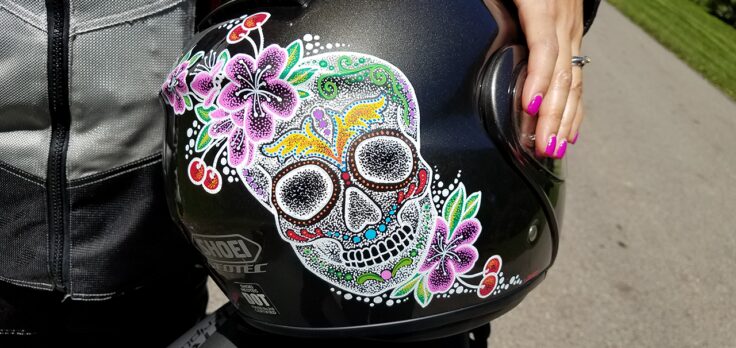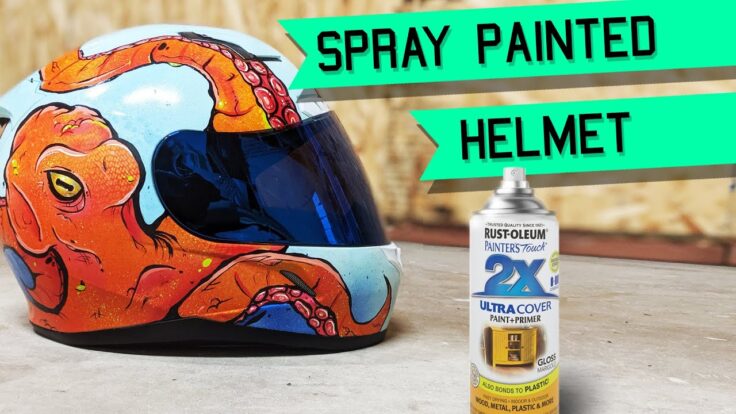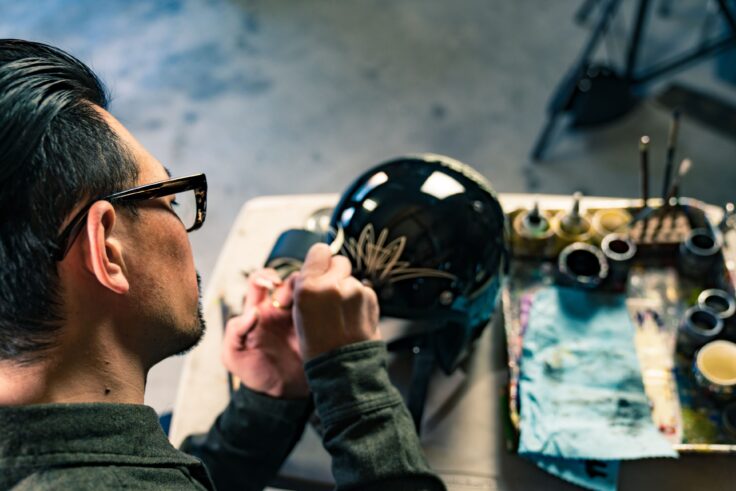Are you bored of the matte and dull design of your motorcycle helmet? If your answer is yes then there are useful guides on how to paint a motorcycle helmet. There couldn’t be any more fun than customizing your own look of your helmet.
There are various DIY hacks on how to paint a motorcycle helmet into however the appearance you like. Painting a motorcycle helmet takes time and effort to show off your artistic and crafting skills.
In this step-by-step guide by Motor Gear Store how to paint a motorcycle helmet requires a lot of courage and patience to achieve the desired results of your painted motorcycle helmet. But before you plan to paint your helmet, you have to be prepared with the availability of painting supplies. And something prepared to prevent from staining onto your clothes.
There are two main methods of how to paint a motorcycle helmet. One can be done with the use of spray paint and the other method is done with acrylic paints. These two methods will ease the hassle of customizing the appearance you achieve for the desired result.
Painting a motorcycle helmet depends on the type of helmet you own and the duration to customize your own graphics. Please to be sure as much as the paint does not affect the functions of the helmet.
These two step-by-step guides on how to paint a motorcycle helmet must carry out the procedures carefully.
Materials needed:

- Airbrush gun or paint spray
- Acrylic paints of your desired color
- Newspapers
- An old shirt or an old apron
- A masking tape
- Flexible stencils (optional)
- Paintbrushes
- Clearcoat spray
- Waxing polish (optional)
- 400 or 600 grit sandpaper
- Marker(s)
- A pencil
Method 1: Painting a Helmet using Spray Paint

- Choose your motorcycle helmet type. Your helmet type will influence the parts of the helmet which needs to be removed before you begin painting. Spread the sheet of newspapers on the surface of your workshop and wear your apron or an old shirt on.
- Start by removing any unwanted stickers except the legal safety standard stamp. Then tape the legal safety stamp.
- Dismantle the helmet by removing visors, inner liner, accessories, padding and others. If you have a full face or dirt bike helmet, remove vents and face shields.
- Lightly wet sand the helmet by using either a 600 or 400 grit wet/dry sandpaper. This prevents fading and color change if this procedure is not done. Also, this will leave the color lasts forever and thus makes it easier to paint.
Note: Do not over-sand the helmet as this will leave marks on the exterior and would weaken the outer shell
- Next, use a masking tape and tape off any parts of the helmet you do not want to paint on. As well as parts of the helmet you want to keep the base color. This may include drawing and cutting out your own designs.
- Once you have finished taping your designs, apply the first color of paint with a paint spray.
- Then spray it again with 2-3 light coats then allow the painted motorcycle helmet to dry completely.
- Then begin taping off your second color. Again, this may involve drawing and cutting out your own designs.
- Once you’ve finished the second taping, apply the next color in light coats. After 2-3 coats, leave them to dry overnight.
- Once dry, remove tape in any areas you want colors to fade together. Then make a stencil of your designs you want to paint next.
- Then lightly spray for desired results. Next, remove the tape where you want to spray the stencil designs you cut out.
- Hold the stencil over the area and spray lightly. Repeat this process as many layers as you want.
- Once you are finished, remove the remaining tape. Then apply the clear coat spray and allow to dry. This prevents the paint to come off.
- Polish your painted helmet with a waxing polish spray and leave it to dry.
- Once it’s dry, reassemble the spare parts of the painted helmet.
- Your customized motorcycle helmet is ready to be used!
Method 2: Painting a Helmet using Acrylic Paint and Paintbrushes

This second method on how to paint a motorcycle helmet has easier instructions than the first one. Rather than with spray paint, acrylic paints, markers and paintbrushes will be used. If spray paint is an issue, acrylic paints are an easy option for painting a motorcycle helmet.
The good thing about acrylic paints is they are easily available and thus are cheaper than spray paints. As acrylic paints do not cause any harm to the exterior of the motorcycle helmet, this method is a good way to show off your creativity of arts and crafts.
- Remove unwanted stickers and dismantle the helmet by removing visors, vents, face shield, inner liner, accessories, padding and others. If you have a full face or dirt bike helmet, remove vents and face shields.
- Spread your surface with a clean sheet or newspapers. To protect yourself from getting acrylic paint onto your skin, wear gloves and an old t-shirt.
- Paint the helmet’s surface with the choice of your acrylic paint. Use the paintbrush to paint only the areas you want to draw.
- Use a pencil to draw your designs on the painted motorcycle helmet. You have to be patient for the paint to be completely dry.
- Paint your designs as many layers as you’ve covered in step 3. It is better to paint the new layer when the old layer is dry.
- Use a marker to redraw the design in order to make it clear. Then leave the overall paint to dry.
- Once it’s dry, reassemble the parts of the painted motorcycle helmet.
- Your painted helmet is customized with acrylic paints!
Tips on Painting Motorcycle Helmet:
– When planning to paint a motorcycle helmet, opt for a black or a white matte helmet as these two colors are easier to paint.
– Take extra care with the exterior of the material when sanding through the helmet with fiberglass composite or molded plastic. This would weaken the surface of the headwear.
– A plain helmet is less expensive than a striking graphic headwear. My advice is to look for a plain helmet regardless of the color as you are going to change the aesthetics anyways.
– Do check the helmet manufacturer before planning to paint your motorcycle helmet. Not all different chemicals would work in all helmet types. If you are anxious about chemicals reacting to the exterior, contact the helmet manufacturer.
– When painting or spraying your helmet, be sure to use a stable stand to hold the helmet in place. This will save time on holding the helmet while spraying.
– When using spray paint or a spray gun, be sure to wear a mask and a pair of strong latex gloves. Along with wearing an old shirt or an old raincoat.
– If you are looking for acrylic paints, make sure the acrylic paints are water-based. This will make it a safe procedure for painting your helmet.
– When waiting for the paint to dry, do check the painted helmet by touching with a gloved finger. If there is no satin of paint, it is completely dry. If there is still some paint on, leave it for a few hours. Do not leave it dry for longer as this will cause a crack.
Simpler Instructions of Helmet Painting
If you are planning to do a simple guide of a painting motorcycle helmet, these simple instructions will help you carry out the process quicker. The simple steps are stated below:
-
Sanding
This process is very important before you spray paint your motorcycle helmet. This will flatten the surface and thus will make it easier to paint the outer shell of your helmet. Make sure you sand all the edges, venting and corner so the color can fit perfectly. The surface must be smooth enough before you begin spray painting.
-
Priming and drying
When using a primer, wear a mask and gloves. This process requires 2-3 coats of primer and leave it overnight. This process makes it standout before painting and thus prevents fading.
-
Guide coat (optional)
The guide coat aids to identify the highs and lows of the colors because of using a darker color over a lighter one, or vice versa. After identifying the contrast of the colors, you should sand efficiently to keep the surface as flat as possible. When you are spraying, the spray coat should be applied lightly and even. Do not rush the process as the spray will become runny.
-
Basecoat (optional)
This is not such an important step. But if you plan to use a base coat, it is best to spray 2- 3 coats evenly.
-
Paint on your color
It is time to paint your favorite color. Make sure you apply the color evenly and apply up to three coats for achieving the desired result.
-
Clearcoat
Clear coat can come with a matte effect or a shiny one. This last step is very important as the color does not come off at all. Once you finished applying paint, don’t forget to apply a clear coat. Apply two clear coatings and allow it to dry.
So here are the two main methods on how to paint a helmet. Both of these methods require effort and creativity. The only difference is these two methods requires different painting materials. Whether painting a helmet with spray or acrylics, helmets will always be a room for customizing the aesthetics of the way you want to display. These twostep-by-step guides will give you the perfect customization of changing from a boring headwear to an exciting painted motorcycle helmet!
Make sure you take care of your safety when you are using any toxic materials. These toxic materials may enter your lungs which you require to wear a mask and a pair of gloves. When using a sharp object, be careful with the way you are handling it. This will cause a deep cutting of your skin.
So use these guides on how to paint a motorcycle helmet and it’s time to show off your creativity of changing your helmet however you like!
You will achieve the effort of a desired result!

